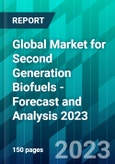Second-generation biofuels, also known as advanced biofuels, are a category of renewable fuels derived from non-food biomass sources. Unlike first-generation biofuels, which are primarily made from food crops such as corn, sugarcane, or vegetable oils, second-generation biofuels are produced from various types of non-food feedstocks, including agricultural residues (such as corn stover and wheat straw), woody biomass, algae, and dedicated energy crops (like switchgrass or miscanthus).
The second-generation biofuels market has been experiencing steady growth, driven by increasing global awareness of the need to reduce carbon emissions and transition to more sustainable energy sources. However, the market is still in its early stages as compared to traditional first-generation biofuels. The market growth was mainly driven by increasing environmental concerns, government policies promoting sustainable energy, and advancements in biofuel production technologies.
Despite the promising growth, the market for second-generation biofuels faced several challenges. Some of the key challenges included high production costs, limited availability of sustainable feedstocks, competition with first-generation biofuels, and uncertainty surrounding government policies and incentives. Incentive programs and mandates in various countries can play a crucial role in stimulating investments in second-generation biofuel production.
The analyst presents a comprehensive report Global Market for Second Generation Biofuels - Forecast and Analysis, which explores the global second-generation biofuels industry and its significant impact on environmental, economic, and technological fronts. The report delves into various forms of second-generation biofuels, assessing their market potential, feedstocks, production technologies, and market overview.
With a special focus on Second Generation Biofuels, the report dissects their characteristics, technological processes, and conversion routes. It extensively covers the diverse feedstocks, including bioethanol, black liquor, and green waste, used in the production of Second Generation Biofuels.
The environmental impact of Second Generation Biofuels, including their influence on greenhouse gas emissions, the carbon cycle, soil, water, and biodiversity, is examined, fostering a comprehensive understanding of their sustainability. The report also scrutinizes the investment landscape, investment costs, and operating costs in Second Generation Biofuels, helping readers identify opportunities for growth and profitability.
Furthermore, the report analyzes over 30 companies actively engaged in the Second Generation Biofuels market, providing valuable insights into their strategies and contributions to this dynamic industry. Country-specific analyses are also presented for Brazil, China, India, Mexico, South Africa, and Thailand, spotlighting their biofuel production, policies, feedstocks, economic and ecological impacts, and strengths.
Table of Contents
Companies Mentioned
- Abengoa Bioenergy
- Air Liquide
- Alto Ingredients
- Amyris Inc.
- Aurora Algae
- BBI Biotech
- Beta Renewables
- BioGasol
- Blue Marble Biomaterials
- BlueFire Renewables
- Butamax Advanced Biofuels LLC
- Chemrec
- Clariant
- ClimeWorks
- Danisco
- Enerkem
- Frontier Renewable Resources
- Gevo
- GranBio
- Gushan Environmental Energy
- ICM Inc.
- Indian Oil Corporation (IOC)
- INEOS Bio
- Iogen Corporation
- Leaf Resources
- Lignol Innovations, Inc
- POET-DSM Advanced Biofuels
- Raizen
- Renewable Energy Group (REG)
- Royal Nedalco
- Sapphire Energy
- Velocys








